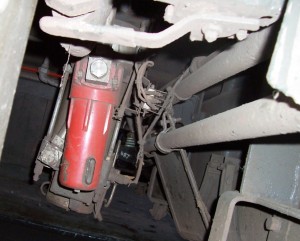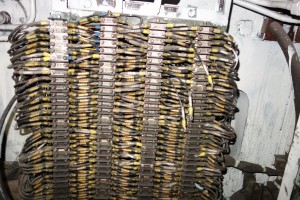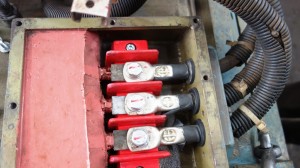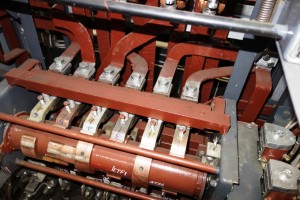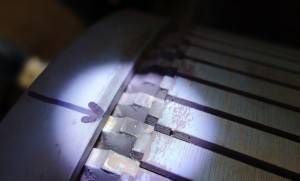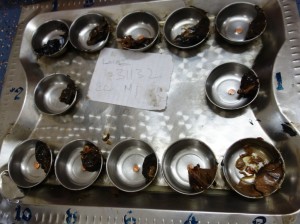Condition Based Maintenance – a cost effective approach
Condition based maintenance, as the name implies, means monitoring and measuring the condition at intervals and decide upon maintenance action as per the condition so evaluated. Thus, the condition based maintenance, also called directed maintenance, differs from preventive maintenance in which the equipment is opened at fixed interval irrespective of its condition.
Indian Railways have followed preventive maintenance as the base maintenance over which system of condition monitoring (mostly instrument based) added to identify defects on the equipment which are difficult to open and breakdown has significant consequential damages. Such condition monitoring, as we all know, are Dissolved Gas Analysis, BDV test, Insulation Resistance Test, Ten Delta Test, Vibration Analysis, Thermal Imaging, Optical techniques ( to enhance the power of naked eye such as magnifying glass, Dye-penetration Test etc.), measurement of ferrous content in bearing, measurement of wearing parts, flow measurement, current monitoring and signature recording etc.
Somehow, the basic conditioning monitoring based on human senses has lost sight which we had relied upon much before the advent of instrumentation based monitoring.
- Visual – Eye
- Aural – Ear
- Tactile – Finger
- Smell – Nose
Look at the system of inspection schedule. It is nothing but condition monitoring by the use of human sensing ability with some measuring devices. The disadvantage are subjectivity, measurement and manual recording. The training and motivation of inspection staff play an important role in identifying the defective condition. Awarding the staff for identifying the defects, which otherwise get unnoticed, is very commonly followed for the prupose of motivation.
Our running staff ( Loco pilot and guard) exchange all right signals with stationery staff ( Station staff, gate-man, key-man). The exchange of signal is nothing but an intimation of all-right condition. The staff has been trained to observe any sign of smoke, abnormal sound, uneven running, hanging parts and is nothing but a sort of condition monitoring for safe running of trains.
I would like to add two more condition monitoring techniques which will help the maintenance man to identify the equipment likely to fail and reduce maintenance cost. These are Air Testing and Thermal Imaging.
Air Testing
This condition monitoring technique concern such rolling stock of which large number of equipment works on air. In electric locomotive, there are large number of equipment which works on air such as brake equipment, DJ, Panto-graph, Horn, GR, Reverser, Line contacter, wipers, sanders, pipe lines etc. The reliability of these equipment depends largely on the condition of rubber items and quality of air used. Two major actions taken to improve its reliability are
- Procurement of rubber items from OEM or from RDSO approved sources in kit form and replacement in kit form as per the defined schedule
- Provision of Air drier to make sure quality of air free from dust, moisture and oil.
These two actions have helped in improving the reliability of equipment working on air irrespective of whether it is for brake, pantograph pipe line, DJ, Circuit Breaker, BA panels, Horn, wiper etc.
There is one very important observation that if there is any defect in any equipment working on air, it will show off in the form of air leakage in idle or operated condition. This basic observation shall be used for condition monitoring. During schedule inspections, the rolling stock shall be fed air supply to its reservoir through an external source and place of leakage identified by the use of aural senses. Generally this is done at the time of testing of the rolling asset as leakage in Kg/min and if within permissible level then Ok. Why permissible level? Because the time available to attend the leakages at this juncture is less and there is urgency to release the rolling stock for service, therefore, permissible level is the easiest option. If the same condition monitoring is done at the time when schedule inspection is going on when external sound level is also less, it will easy to detect and leakages are attended with care. The permissible level of leakages will come down significantly. This condition monitoring system will have the following advantages
- Any defect in its very early stages is detected and attended within reasonable time
- Energy efficiency as leakage of compressed air cost money
- Overhauling schedule can be reviewed and thus the frequency of replacement. It will save money on overhauling kit. The system will permit the component to work for its life.
- There are many equipment mounted on the roof of the locomotive like horn, pantograph, DJ etc. and it is difficult to identify the location of leakage on the roof in energized condition.
Thermal Imaging
Thermal imaging is the method of identifying hot spot. The hotspot is an indication of a defect which otherwise cannot be detected. This technique is followed very sincerely in Traction Distribution installation but not in other areas. A loose connection in power circuit cable or bus-bar of a locomotive or Electrical Multiple Unit is a sure shot case of developing into a failure or fire as there is no protection system to identify such defects till such time converted into earth fault. Thermal imaging of power connections immediately after its working can help in identifying the most vulnerable defects. Traction Motor connections is the first priority area where this can immediately be used.
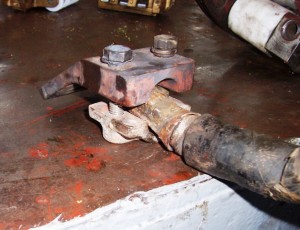
Other Condition Monitoring Techniques
To help the maintenance engineers, many instruments based condition monitoring techniques have been developed. This has benefited maintenance engineers in following way
- To approach any un-accessible area which otherwise is not possible
- To avoid opening of an equipment which would have otherwise taken time, money, manpower etc.
- Continuous automatic monitoring through in place sensor thus saving on manpower
These techniques are detailed as follows
Optical Techniques
Use of eyes is the fundamental condition monitoring technique. But there are certain defects which are not visible through naked eyes. Magnifying glasses available to enhance the size of the image. Similarly the object to be inspected is hidden and requires specialist equipment to get round the problem of inaccessibility. There are mainly two types of instruments
- Borescopes are purpose-built devices which use a liquid or fiber optic light guide, both to illuminate and visualize the object. They can be rigid or flexible and, depending upon the manufacturer, incorporated a selection of interchangeable heads.
- Light probes, which are flexible light sources and can be used along with a mirror and a stick
There are object to be inspected but rotating at high-speed. There are equipment which freezes this movement so that the object can be monitored with stopping the equipment.
These techniques are not very commonly used but very important condition monitoring devices to delay opening and removal of equipment from service.
Thermal Techniques
Any defects commonly show in the form of producing heat and very useful method of detecting defects. There are two applications
- To monitor the temperature of the process fluid/motor winding/surface temperature of heat sink continuously
- Scanning Infra Red cameras which produce a thermal display of the components under observation
Indian Railways use this technique very commonly for detecting loose connection in traction distribution.
Vibration Techniques
Vibration measurement has proved a very versatile tool. Many forms of measurement have been developed to assess condition and diagnose the fault. It is also observed that the noise produced from the unacceptable level of vibration can easily be detected by aural senses. Nevertheless, this will be very important when many machines are working together or machine is operating in very noisy environment. The success of vibration measurements is based on the ease of accurate diagnosis and the fact that it is a non-intrusive method.
The most simple vibration monitoring technique is the measurement of overall vibration in the acceleration, velocity or displacement domains. This method quantifies the amount of vibration which is compared to the accepted norm and alarms set. There are three domains of measurement i.e. acceleration, velocity and displacement Acceleration domain is sensitive for rolling element. Velocity measurements are useful in detecting balance, misalignment and looseness. Displacement is biased to low-frequency vibration and is used for slow speed equipment.
Bearing deterioration normally takes the form of pitting in its first stages. Pitting leaves defects and produces debris which in turn acts as an abrasive within the bearing. The impacts caused by rolling elements colliding with these defects produces high frequency vibration within the bearing and housing. It has been proved that the bearing damage can be monitored at an early stage and therefore, unexpected breakdowns are easily avoided.
We have not been able to monitor the condition of traction motor bearing ( own and suspension bearing) and its failure results in an axle locked condition which results in immobility of the rolling stock.
The defects which results in vibration and can be identified are
- imbalance
- misalignment
- looseness
- bearing damage
- gear damage
- oil whirl
- blade damage/crack
- cracked shaft
Performance Monitoring
Performance monitoring items are defined particularly for acceptable norms. For evaluating defects from performance monitoring items, it is necessary to record the measurement of 100 equipment/day/time etc. and benchmark the one which will be used for the purpose of detecting defects. Air flow, liquid flow, air leakages, vacuum leakage, oil leakage, etc. are parameters monitoring of which will give a good idea of the condition of what is happening inside.
Current Monitoring
Motor current can be measured quite simply using a variety of techniques. Logging of current with time is the most common method. Peak of current during a cycle can be measured. This is called taking a current signature and is very useful tool in identifying the working environment of the motor. Spectrum analysis can be used to diagnose broken or cracked rotor bars, uneven air gap and shorted field winding.
Lubricant monitoring
A lubricants in service consist of two parts namely
- Base oil plus additives
- Contaminants
The base oil and additives provide the lubricating properties of the oil whilst the contaminants are found in the form of solids, liquids or dissolved gases. The contaminants enter the oil as it circulates and their presence in the oil produces a unique history of the oil. There are two categories of lubricant monitoring
Lubricant Condition: This indicates the effectiveness of the lubricant
Wear Debris monitoring: which highlight the development of defect and prevailing condition of its development into failure.
This is commonly used wherein the ferrous content of axle box ( 12 in numbers) grease is measured and defects identified.
Dissolved Gas Analysis
Dissolved Gas Analysis is the study of dissolved gases in transformer oil.
Insulating materials within transformers and electrical equipment break down to liberate gases within the unit. The distribution of these gases can be related to the type of electrical fault, and the rate of gas generation can indicate the severity of the fault. The identity of the gases being generated by a particular unit can be very useful information in any preventative maintenance program.
Dissolved Gas Analysis techniques is very regularly followed in Indian Railways in which the transformer oil sample is taken out at intervals and tested for dissolved gases. The percentage of dissolved gases give the idea of the nature of defect if any. Any defect in the transformer produces hot spot, sparking, flash-over etc. which results in the production of such gases. This test is being done under the surveillance of RDSO and performed by trained staff.
Maintenance engineers shall take call to declare transformer as maintenance free item except for monitoring its condition by dissolved gas analysis.
Ultra Sound Defect Analysis
This is the most commonly used technique to detect flaws in axle and wheel which relates to safety. A fine crack on an axle starting at ridge may become a potential fracture if not detected early. This technique employs ultrasound send from one end and reflected wave is analyzed. The reflected image contains the information about any irregularity in its travel and bounce back. This test is done under the surveillance ofRDSO and only trained staff are nominated for the purpose. A defect identified by Ultra Sound flaw detection and shown after dismantling and developing by dye-penetration test.
Benefits of Condition Monitoring Technique
Condition monitoring techniques are the most important tools towards cost-effective maintenance. In Indian Railways, this has been employed for the purpose of identifying defects which are not easily accessible and having safety implication. Somehow, no thought has been given to take its advantage for cost effective maintenance. Assessment of the life of a component is generally based on experience. The experience is based on its trend of failure. If the experience says, it is three years, then it is replaced every three years. Now the component will never get an opportunity to perform beyond three years. Unless an equipment/component gives an opportunity to perform for its life, life determined or fixed is arbitrary.
Condition Monitoring is the best technique to assess the life of every component by giving it an opportunity to work for its life. This also ensures reliability and safety.
Indian Railways are generally working on the principle of preventive maintenance and replacement of equipment/component based on the life fixed in consultation with the supplier.
I had the opportunity of visiting DMRC. The working principle is condition monitoring. However DMRC had the advantage that the rolling stock works in close reach of maintenance man who is not so for the Indian Railways. But it is also important to note that rubber components which is planned for replacement every 1/3/6 years in Indian Railways has been working comfortably for the last 10 years. It is not that it cannot work in Indian Railways, but it is because the life is fixed based on experience and not by giving the component an opportunity to perform for its life.
Condition Monitoring is a sure shot way of assessing the life of equipment/component
More scientifically and
Without sacrificing on
Reliability and Safety
There is a post on Linkedin by Mr. Arun Saxena and reproduced as follows:
Arun Saksena Network Monitoring Centres in Telecom and Signal Data Logging Management Centres have made significant headway in the field of Condition based Predictive Maintenance on Indian Railways. The monitoring is On Line and Continuous and as soon as the degradation in a particular parameter or an abnormal relay sequence is noticed alarm is generated and displayed on screens for maintenance teams to act


